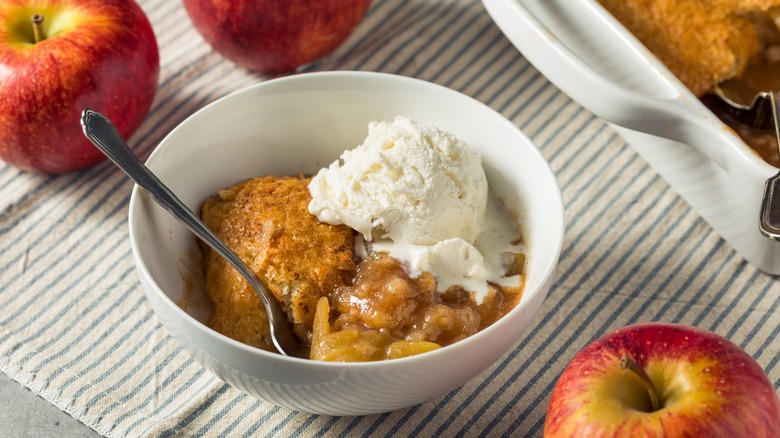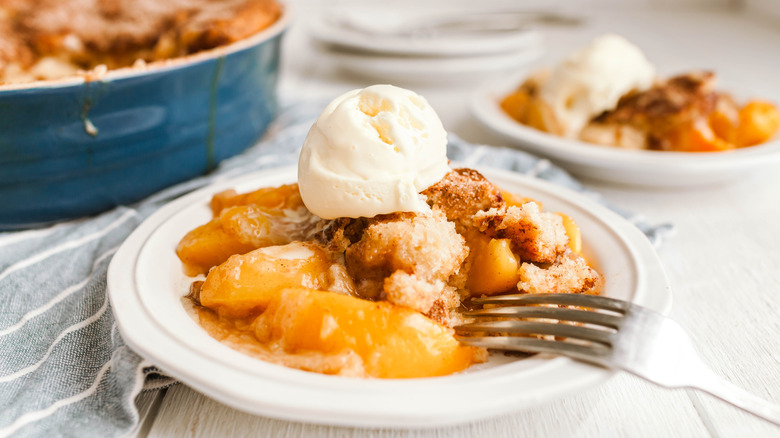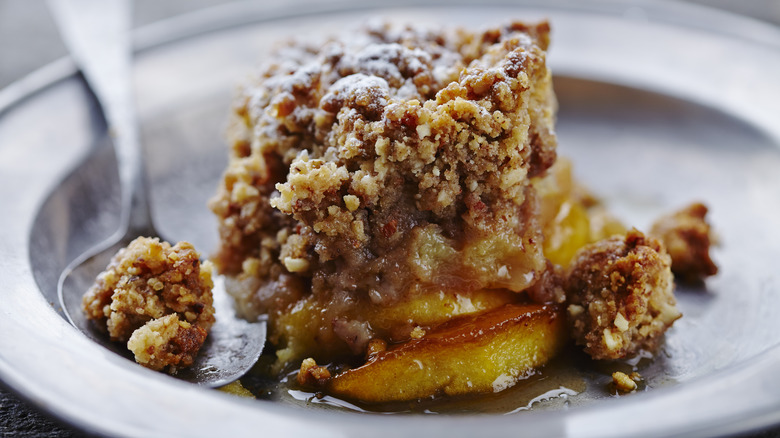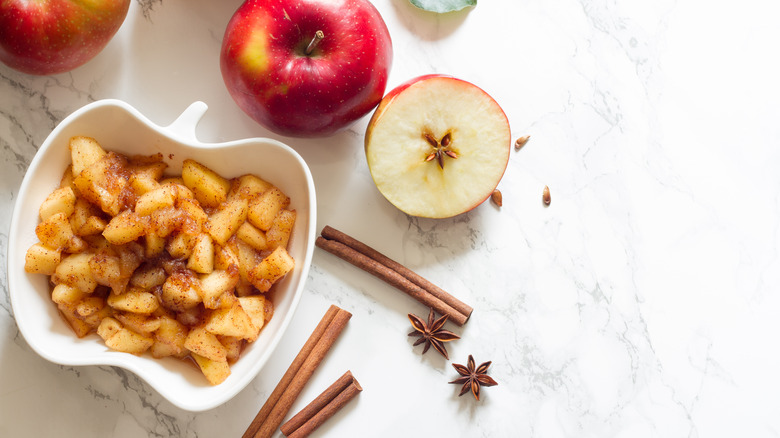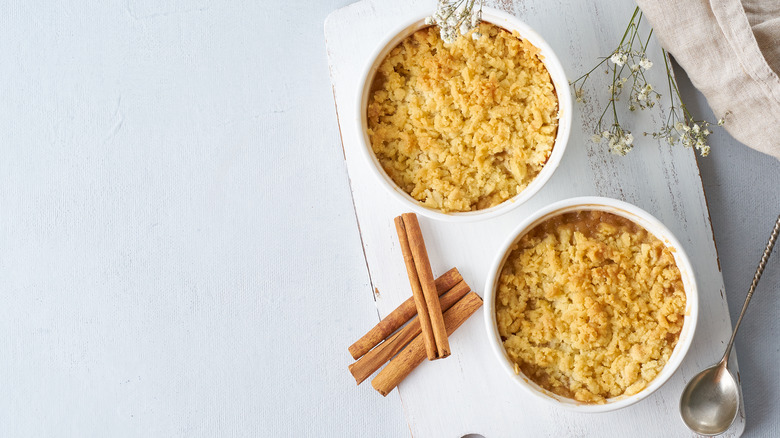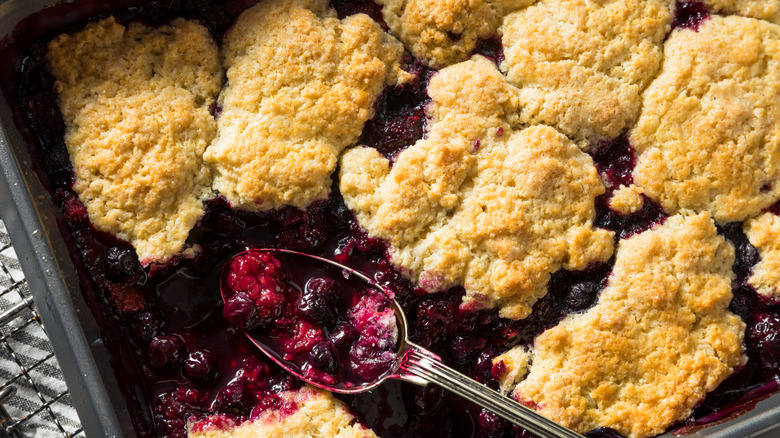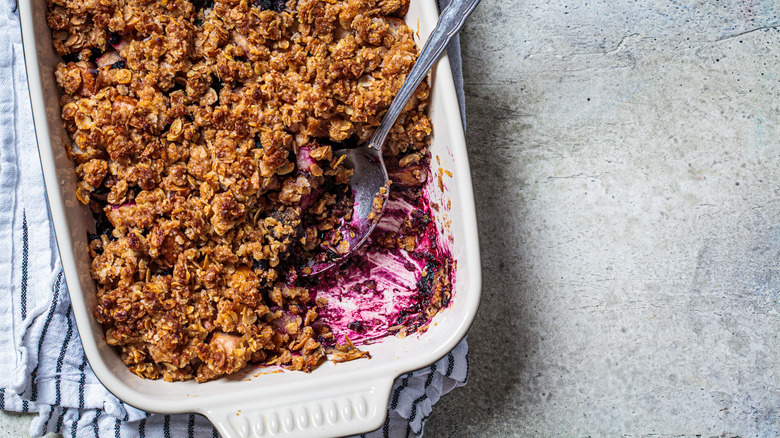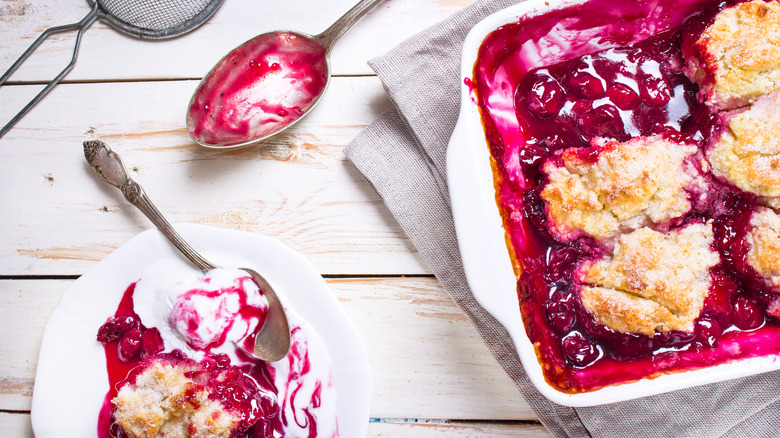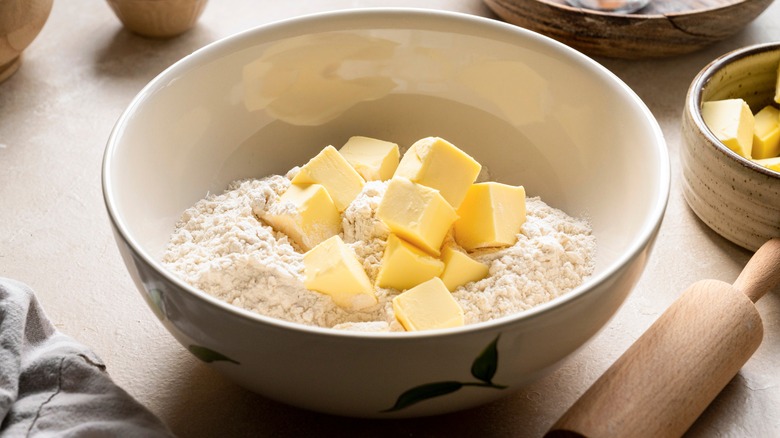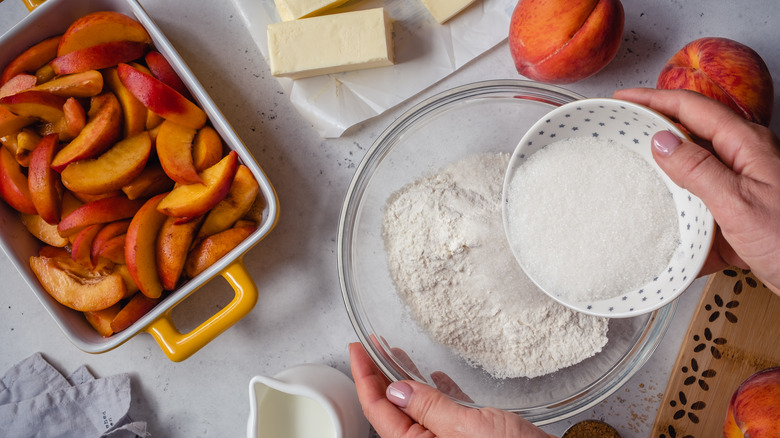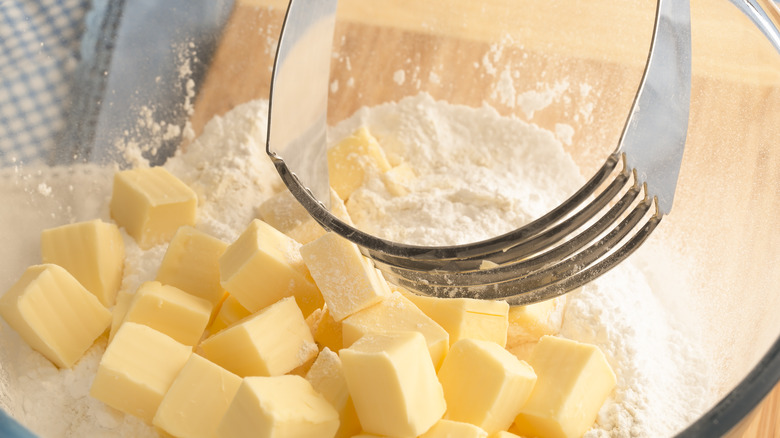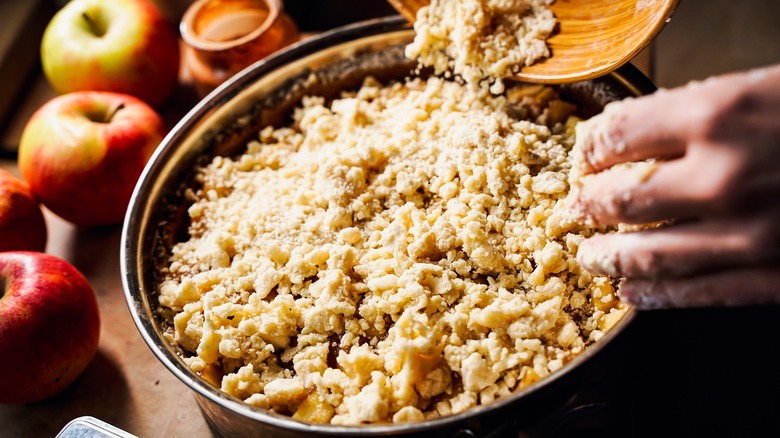Cobbler Vs Crisp: What's The Difference?
It's time to enter the delicious world of fruity desserts with a showdown between two iconic contenders: cobbler and crisp. Picture this: It's a cozy Sunday afternoon and the aroma of baked goodness fills the air. You're torn between indulging in a warm cobbler or savoring a crispy, fruity delight. Which should you choose? We're here to unravel the mysteries. We all know these desserts belong to the same family of comforting, fruit-centric sweets. Yet each has its own unique flair and personality, creating a delightful dilemma for dessert enthusiasts everywhere. Let's break it down.
Cobblers, with their rustic charm, typically feature a fruit filling nestled beneath a layer of buttery, biscuit-like dough. There's a delicious balance between the richness of the filling and the flakiness of the crust. On the other side of the dessert arena, we have crisps. Imagine fresh, seasonal fruits topped with crumbly streusel. The magic happens in the oven as the topping turns golden brown and — you guessed it — crispy.
We'll explore the variations and subtle nuances that set these desserts apart. Whether you're a keen baker or just someone with a sweet tooth, we're here to guide you through the delectable realm of cobblers and crisps. There's more to these desserts than first meets the eye and you're about to learn all you need to know.
What is a cobbler?
A cobbler is a classic dessert that has been gracing tables for generations, so it evokes nostalgia and comforting vibes. But, what exactly is a cobbler? In short, it's a blend of fruit and a biscuit-like topping. Picture a baking dish filled with juicy, sweet fruits like peaches or apples, all blanketed beneath a golden-brown crust. The crust can be a rolled or dropped dough, giving it a rustic and homely charm. The term "cobbler" is said to originate from the dropped biscuit topping creating a cobblestone-like appearance.
Cobblers are versatile and can showcase a variety of seasonal fruits, making them a favorite for gatherings, celebrations, or just a cozy night in. The contrast between the tender fruits and the flaky, buttery crust creates a tasty balance of flavors and textures. Whether served warm with a scoop of vanilla ice cream or enjoyed on its own, a cobbler is a timeless dessert that's sure to remain a favorite for generations.
What is a crisp?
Now it's time for us to give you the lowdown on crisps. The crisp is a fruit-filled dessert with a crunchy, textured topping that steals the show. Its charm lies in the simplicity of its preparation: a mixture of fruit, sugar, and sometimes spices, crowned with a topping of oats, flour, butter, and sugar. It's all layered in a baking dish and then baked in the oven, where the concoction transforms into a golden, crispy delight.
As for the name crisp, it beautifully encapsulates the dessert's defining feature: that irresistible crunch. It's a straightforward and fitting moniker that has stood the test of time. This dessert is not dissimilar from a cobbler, as it features a fruity base with a sweet, starchy topping, but the topping is quite different in both ingredients and texture. This is the most obvious place that the two types of desserts deviate from one another.
What are their interiors like?
You don't have to ask us twice to dig right into the core of cobblers and crisps — the luscious fillings that make these desserts the delightful treats they are. Both types of desserts feature fruit interiors under their distinct toppings. There are some differences, but ultimately, they're versatile desserts that you can make with almost any type of fruit.
When it comes to cobblers, there's a certain art to choosing the right fruit. We're talking about the kinds of fruits that hold their shape and texture even after a rendezvous with the oven. Firmer fruits such as apples and peaches are the MVPs here. Avoiding overly juicy or watery fruits prevents excess moisture from seeping into the crust, ensuring it cooks well and doesn't get soggy.
But what about crisps? Here, the rules of the game are a bit more forgiving. Crisps embrace the softer, juicier side of the fruit spectrum. The beauty of a crisp lies in the way the fruit juices bubble up through the layers. Soft and even slightly mushy fruits are welcomed with open arms, adding a delightful contrast to the crunchy topping.
So, while cobblers and crisps share the common thread of fruity goodness, the art lies in choosing the right fruits for the job. That said, some rules are meant to be broken and it's fine to experiment.
How are their toppings different?
It's time to move on to toppings, the crowning glory of cobblers and crisps. This is where their differences start to become more obvious. Cobblers often boast a topping that resembles a cross between a biscuit and a dumpling. Think buttery, flaky goodness that crowns the fruity filling like a cozy blanket. The texture is hearty, offering a substantial bite that beautifully complements the tender fruits below. The cobbler topping, whether dropped in spoonfuls or rolled out, transforms into a golden crust in the oven.
Now, shift gears to crisps. These desserts take a different approach to the topping game. Crisps are characterized by a more granular, crumbly streusel layer that's a medley of oats, flour, butter, sugar, and occasionally chopped nuts.
Comparing the two, cobblers offer a heartier experience, with the topping forming a substantial crust. It's a delightful marriage of textures, with the flakiness of the crust juxtaposed against the gooeyness of the fruit. Crisps bring a lighter, more crumbly texture to the party. The topping is sweet, crumbly, crunchy, and sometimes infused with fruit juices that bubble up through the layers.
What do they look like?
Although cobblers and crisps don't look entirely dissimilar, it's easy to tell them apart. Cobblers have a textured crust that's made out of dough. Picture a patchwork of golden-brown mounds dotting the surface where the topping is dropped onto the fruity filling. They can look smoother or more lumpy in appearance, depending on the recipe and the exact style of topping. As the cobbler emerges from the oven, the fruits peek through the gaps in the crust, hinting at the delicious filling beneath.
Moving on to crisps, picture a different kind of beauty: a landscape of golden-brown crumbs atop a pool of soft, juicy fruit. You'll see pieces of oats and perhaps nuts, if used, in the streusel-like topping, with some of the juices from the fruit bubbling up amongst the filling or around the edges. Both desserts have a more rustic appearance than, say, a fruit pie.
What do they taste like?
Let's start with cobblers. If you've eaten biscuits or scones, the flavor of the topping is fairly similar. It has a butteriness to it and is sweet, though not overly so. This flavor gives way to sweet, tender fruits beneath. The combination of the slightly caramelized exterior and the gooey, syrupy fruit filling is delicious. Of course, the flavor will vary depending on the type of fruit used, whether peach, apples, berries, or something more adventurous.
Crisps have a different flavor profile due to their crumbly topping. The topping of a crumble tastes a lot like the streusel part of a coffee cake, so if you've tasted one of those, you're on the way to understanding what a crisp tastes like. However, the oats (and nuts when used) bring their own flavor to the party. Some recipes add spices, such as cinnamon, to the topping, which adds an extra layer of flavor. This crunchy, buttery, oaty topping yields to the juiciness of the fruit. The sweetness of the baked fruit is a pleasant contrast to the crunchy topping.
Cobblers and crisps have some flavor similarities, but their toppings taste notably different. Both the fruit and the topping bring something to the table.
How is their texture different?
Cobblers have a texture that is simultaneously flaky and tender. Some recipes lean into the flakiness of the crust with a texture like laminated biscuits, whereas some are more scone-like. Imagine the first forkful: there's a satisfying resistance as you break through the golden-brown exterior, revealing the soft, gooey fruit filling beneath. The crust, while maintaining a substantial presence, often features pockets of airiness, creating a delightful interplay between the more robust outer layer and the tender, syrup-soaked interior.
Crisps have a crumbly topping that adds a crunch to the experience. The texture is a bit like a streusel topping on a crumb cake or like breadcrumbs. However, you have a little more crunch and texture from the oats and sometimes nuts. The top should be very crisp, but sometimes there's a slightly stodgy layer where the fruit meets the topping. The fruit below the crisp layer is soft and sometimes syrupy. The contrast of the crunchy topping with the juicy, tender fruit creates a nice balance, making each spoonful an exploration of textures.
To sum it up, in terms of toppings, cobblers offer a denser, heartier texture with a substantial crust, while crisps have less topping and a crunchier texture. However, in both cases, the texture of the fruit layer is similar.
What ingredients do they contain?
Starting with cobblers, the star of the show is the crust that's layered over the fruit. This crust typically involves basic pantry staples such as flour, sugar, baking powder, salt, and butter. Some recipes might add a touch of milk or buttermilk to enhance the tenderness of the crust. As for the filling, cobblers can showcase an array of fruits like peaches, apples, berries, or cherries. Sugar and sometimes a hint of spice are added to the fruit to coax out their natural sweetness and flavors. Some recipes also use a little citrus in the fruit filling to balance the sweetness.
Crisps use similar ingredients, but there are some differences. Like cobblers, the topping includes flour, sugar, and butter. However, it also contains oats and occasionally nuts. The oats contribute to the texture. Additional ingredients like cinnamon or nutmeg may be thrown into the mix for a touch of warmth and spice. The topping doesn't rise, so it doesn't need baking powder, like cobblers do, nor does it need extra liquid from milk or buttermilk. When it comes to the fruit filling, crisps welcome a variety of options from the classic apple to berries, peaches, or even rhubarb. The filling is usually sweetened with sugar and may include a splash of citrus juice to brighten the flavors and provide balance.
How are they made?
While they're in the same family of desserts, there are some differences between making crisps and cobblers. The process of making cobblers generally involves creating a dough for the crust. In a mixing bowl, you'll combine all the dry ingredients. Cold butter is then cut into these dry ingredients until the mixture resembles coarse crumbs. Some recipes might call for a liquid to bring the dough together. The fruit filling is prepared separately, combining fresh or canned fruits with sugar and, if desired, a touch of spice. The fruit mixture may be cooked in a pan before it's spread in a baking dish, and dollops of the biscuit dough are dropped on top. As it bakes, the crust rises and browns.
On the crisp side of things, the process takes a different turn. To prepare the topping, all the dry ingredients are combined, and then the butter is cut in until the mixture reaches a breadcrumb-like consistency. Some recipes might include chopped nuts or spices for added flavor. The fruit filling is mixed with sugar and may or may not be cooked before further baking. The fruit mixture is then spread in a baking dish, and the crumbly topping is generously scattered over the top. The filling and topping are then baked together until the topping is crunchy and golden brown.
Which is easier to make?
If you're thinking of making one of these desserts, you might be wondering, "Is it easier to whip up a cobbler or a crisp?" Let's roll up our sleeves, put on our aprons, and find out. We'll begin with cobblers. While the dough itself is fairly straightforward, achieving the right texture and consistency requires a bit of finesse. Cutting in the butter and ensuring the dough isn't overmixed are crucial steps. The fruit filling sometimes needs cooking before adding it to the baking dish, but it's a simple process.
When making crisps, there's a similar cutting in process for the topping, which is a little fiddly and time-consuming. However, it's basically impossible to overwork the topping and turn it tough like you can with cobbler topping. The process for making the fruit filling is identical to cobblers, and then you just chuck the crisp topping on and bake.
Many bakers would argue that crisps hold the title for ease. The crumbly topping is forgiving and doesn't require the same level of precision as the cobbler's dough. That said, both are fairly simple to make, so you should choose whichever dessert appeals to you most.
Which is quicker to make?
Want dessert in a hurry? Let's find out if cobblers or crisps are quicker to make. The fruit filling of both crisps and cobblers takes the same length of time to make. Recipes that don't pre-cook the fruit before layering and baking are quicker.
There is a difference in the cooking time. Crisps tend to take somewhere around the 30-minute mark to cook, while cobblers can take around 45 to 55 minutes. That's not an insignificant difference when you're desperate for dessert. That said, the use of canned biscuit dough in cobblers is a game-changer for those seeking a shortcut. This pre-made dough significantly expedites the cobbler-making process. Simply pop open the can, arrange the biscuit rounds over the fruit filling, and you're on the fast track to cobbler bliss.
The crisp has a slight edge in terms of speed. While canned biscuit dough can certainly expedite the cobbler-making process, the simplicity of the crisp's topping trims down the overall preparation time if you want to make everything from scratch. Crisps are the go-to option for those craving a speedy yet satisfying fruity dessert fix.
If you're aiming for a quick dessert without compromising on flavor, the crisp emerges as the swift champion. However, with the savvy use of canned biscuit dough, a cobbler can also join the express lane, offering a delightful treat in a fraction of the time.
